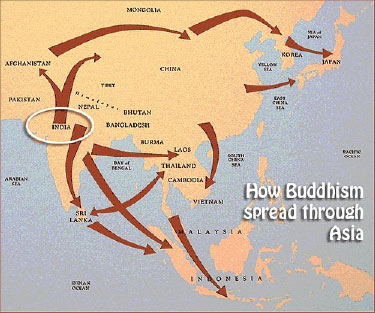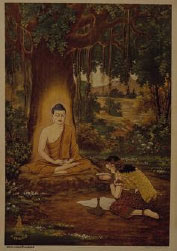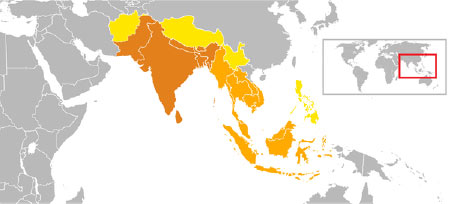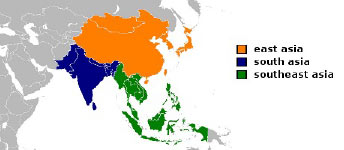PARALLELS BETWEEN HINDUISM AND BUDDHISM
By Baba Vickhram Aditya Bedi

Hinduism and Buddhism share common beliefs in Dharmic concepts.
In the totality of the history of Indian Civilization, the distinction between Vedism, Hinduism, Buddhism and Sikhism were not labels that Indians themselves placed. In fact these divisions were created to classify different movements of thought and reforms, which came about throughout the course of the Indian Civilization. No moment existed when Siddhartha Gautama stated that he was founding a different religion, in fact he could not state this even if he wished, because the core concepts of Vedism carried forward, the concept of Karma, Dharma and Janaam, or the cycle of rebirth were not only accepted but reaffirmed. Even the common stories which we associate with Hinduism were carried into the Buddhist Reforms. This is not to say that Buddha’s divine enlightenment did not take a modified direction, but the direction and message disseminated the common culture of the Pan-Indian world of that time. Even the language used which became known as Pali, was one which was understood by North Indians in this epoch and by all logic was a common spoken form of Classical Sanskrit.

Pali Script
The Buddha stressed equality in his message, but even more than this, he strove to eliminate human suffering. His message would move away from the pivotal centrality of the acceptance of the presence of the supreme being, to one which became rather neutral to the importance of this focal point, and instead shifted to the actions which humanity could make to better the condition of itself as a whole. The path of detachment, which existed in ancient India, was prescribed to all. Though the elements were found in Vedism, detachment had been for the aged in general and less for the householder. Ultimately, the change was creation of choice, which spread throughout India and ultimately much of Asia.

The Buddhist movement was not shunned by Indians, because though it was viewed as a reform movement, it was not considered foreign in concept. It eventually even found its way to the Emperor of India. Emperor Ashoka would accept many elements of the reform movement. The reasons for this may have been the bloodshed of the first Indian Unification and in particular the Kalinga Campaign. What is clear is that Emperor Ashoka achieved military victories on a scale which were unparalleled in the ancient world, but his later mission of spreading humanistic reforms the likes of which had never been done before, it is clear that the Buddhist reforms were spread by direct sponsorship of the world’s largest Empire and the most prosperous one.

Hindu Influence in Japan. By many accounts 80% of the deities in Japan are of Indian origin.
The fact that this occurred during the rule of Emperor Ashoka is a fact which cannot be taken out of historical context, for it would be the common culture of India at this time which spread throughout Asia. The fact that he himself was a product of his time is a snapshot of the realities of India of that time. His edicts still stand thoughout modern India, and they show a ruler who had great concern for the governed. Emperor Ashoka not only cared for his subjects but believed that the state had to provide for medical care, ensure safe roads and promote higher ethics. For those who were punished, he saw no reason for harshness nor for the labelling of these people. In fact, he wanted them to have complete access to his office for appeal and reconciliation. He granted animals basic rights, and even created ecological law for the protection of India’s forests and its creatures. His rule was one which became a legend, so much that many doubted such an Emperor ever existed, but his truth emerged again as the Brahmi Script was deciphered. The star of Emperor Ashoka still gives light to India and the world.

Emperor Ashoka and the rock edicts.
In Buddhist texts the recognition of Emperor Ashoka is still present, his role is well understood to have been crucial in spreading the philosophy, yet a broader concept is often lost and this is that Emperor Ashoka was himself a contributor of ideals, which spread at the same time. His son Mahindra and Daughter Sanghamitta, both spread the reforms of the Mauryan Empire. The concept that a super state such as what had been created to voluntarily cease expanding when it could not be defeated but instead chose to spread its scientific, cultural, and philosophical basis for the benefit of humanity remains extraordinary.

Emperor Ashoka and the adoption of the Buddhist reforms.
The reforms of Buddhism had by the age of Emperor Ashoka in 260 B.C. already become part of the common culture of India. In the coming centuries, Hinduism and Buddhism in practice would become hard to differentiate. Hinduism had always had multiple paths in it, and Buddhism’s concepts of “Ahimsa Parmo Dharma”, or “Non-Violence is Religion”, were present in the Vedas though emphasis as a goal and not universally prescribed. Yet, by the Gupta age in India, it was common for Buddhist institutions to find support from Hindu rulers. The reality was that rulers did not view these institutions as separate, but rather very much their own. In fact a tradition had already developed, the financial and political support, which a ruler gave, would not constitute the ability to academically interfere within Buddhist Universities. The acceptance of this line, was not one which came about because of difference but rather because of sameness and a sense of fairness.
It may well be said that Hinduism and Buddhism even today in India cannot be distinguished, as a Hindu has reverence for the Buddha and does not view his teachings as separate but more as a choice. When looking at Asia as a whole, it can be seen clearly that where Buddhism was spread the mythology of India at that time also spread. In fact even today we can see that many of the deities in Japanese tradition actually have their origin in India.

The Indo-Sphere and spread of Indian Civilization apart from the spread of the Buddhist reforms.
When stating that Hinduism did not spread like Buddhism is really not accurate, as its philosophical basis could not be separated. The metaphors in Buddhist texts were based on Indian Civilization. The attempt to create separation in the long continuum of Indian Civilization was a pursuit which began during the Islamic Invasion and then relented largely after the bhakti movement begun by Guru Nanak Dev Ji and Sant Kabir, by the time of Emperor Akbar and later Prince Dara Shikoh it was extensively written that India was itself a continuous civilization, in the works Abu’l Fazl the concept is not just discussed but accepted beforehand. In the later Majma Ul Bahrain, written by Prince Dara Shikoh, even the title itself means, The Confluence of Two Oceans, respectively this is the Islamic World and the Vedic or Dharmic world which was and is centered in India. The message of this work was universal and one finding, that of commonality.

With the beginning of the Western colonization of India, the idea of studying India, would soon turn into a pursuit of justifying occupation of India. For the British Empire this was largely based on superficial understanding of Vedic Sanskrit and later when familiarity had been gained it was tilted to create division where none had existed before. The fact that Ancient India has so successfully spread its civilization thousands of years before and the fact that not only was it documented but apparent was just one of many achievements which had to be reduced. Just as the imaginary invasion of India by Aryans was based on misinterpretation of the Vedas, attempts were made that Indians would be separated from their historical accomplishments. This history, however, always has been transparent, an India which has after so much suffering and time, regained independence and once more today once more interprets its own history in the context that world’s oldest continuous civilization always did in ages past.